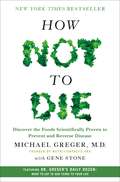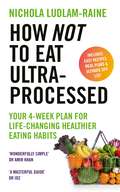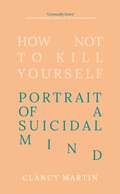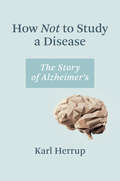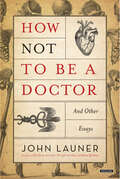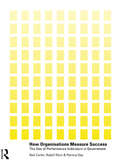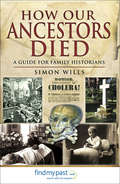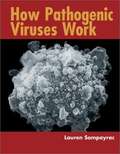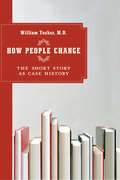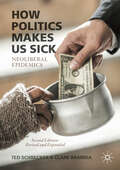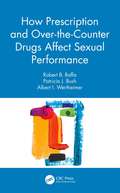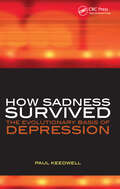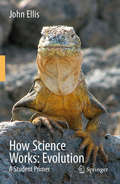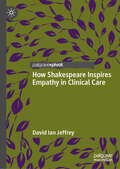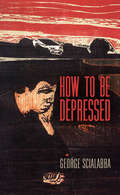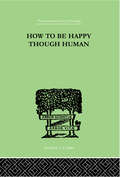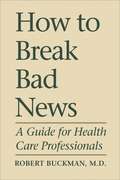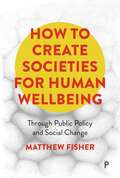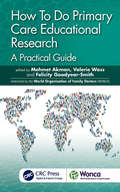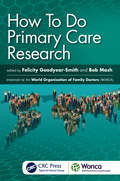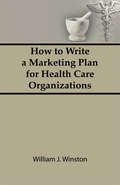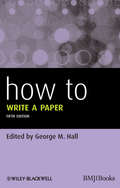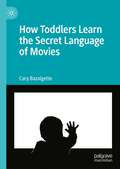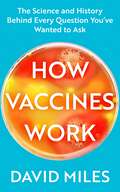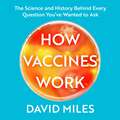- Table View
- List View
How Not to Die: Discover the Foods Scientifically Proven to Prevent and Reverse Disease, First Edition
by Gene Stone Michael GregerIn How Not to Die, Dr. Michael Greger, the internationally-renowned nutrition expert, physician, and founder of NutritionFacts.org, examines the fifteen top causes of premature death in America-heart disease, various cancers, diabetes, Parkinson's, high blood pressure, and more-and explains how nutritional and lifestyle interventions can sometimes trump prescription pills and other pharmaceutical and surgical approaches, freeing us to live healthier lives.
How Not to Eat Ultra-Processed: Your 4-week plan for life-changing healthier eating habits
by Nichola Ludlam-RaineWe know we should eat fewer ultra-processed foods; this book shows you how to do it.From expert dietitian, Nichola Ludlam-Raine, comes this simple, easy-to-follow plan for reducing the ultra-processed foods in your diet.Taking you through 4 weeks, each focused on a different meal (snacks and drinks, breakfast, lunch and dinner), Nichola equips you with the practical ways you can make a huge difference to your diet through small, achievable changes.Along the way she also debunks the myths that surround ultra-processed foods and provides answers to the most commonly asked questions, to help soothe anxiety around what you eat and enable you to feel confident with what's on your plate, wherever you are and whatever time of the day.With recipes to get you started and a comprehensive list of over 100 processed and ultra-processed foods, ranked according to their nutritional benefits and with guidance on how often you should eat them, this is a necessary guide for anyone looking to eat healthier and make a real change to their long-term health.
How Not to Kill Yourself: Portrait of a Suicidal Mind
by Clancy MartinThe last time Clancy Martin tried to kill himself was in his basement with a dog leash. He didn&’t write a note. How Not to Kill Yourself is an affirmation of life by someone who has tried to end it multiple times. It&’s about standing in your bathroom every morning, gearing yourself up to die. It&’s about choosing to go on living anyway. In an unflinching account of his darkest moments, Clancy Martin makes the case against suicide, drawing on the work of philosophers from Seneca to Jean Améry. Through critical inquiry and practical steps, we might yet answer our existential despair more freely – and with a little more creativity.
How Not to Study a Disease: The Story of Alzheimer's
by Karl HerrupAn authority on Alzheimer's disease offers a history of past failures and a roadmap that points us in a new direction in our journey to a cure.For decades, some of our best and brightest medical scientists have dedicated themselves to finding a cure for Alzheimer's disease. What happened? Where is the cure? The biggest breakthroughs occurred twenty-five years ago, with little progress since. In How Not to Study a Disease, neurobiologist Karl Herrup explains why the Alzheimer's discoveries of the 1990s didn't bear fruit and maps a direction for future research. Herrup describes the research, explains what's taking so long, and offers an approach for resetting future research.Herrup offers a unique insider's perspective, describing the red flags that science ignored in the rush to find a cure. He is unsparing in calling out the stubbornness, greed, and bad advice that has hamstrung the field, but his final message is a largely optimistic one. Herrup presents a new and sweeping vision of the field that includes a redefinition of the disease and a fresh conceptualization of aging and dementia that asks us to imagine the brain as a series of interconnected "neighborhoods." He calls for changes in virtually every aspect of the Alzheimer's disease research effort, from the drug development process, to the mechanisms of support for basic research, to the often-overlooked role of the scientific media, and more. With How Not to Study a Disease, Herrup provides a roadmap that points us in a new direction in our journey to a cure for Alzheimer's.
How Not to be A Doctor: And Other Essays (Royal Society Of Medicine Ser.)
by John Launer&“Humorous, poignant, provocative and educational,&” this essay collection by a doctor &“offer[s] fresh takes on the ever-changing field of medicine.&” (Kirkus Reviews) Doctor and medical columnist John Launer has written on the practice and teaching of medicine for many years. How Not to be a Doctor includes over fifty of his essays covering a range of topics including music, poetry, literature, and psychoanalysis, as well as contemporary medical politics and the personal experiences of being a doctor. Taken together, they set out an argument that being a doctor—a real doctor—should mean being able to draw on every aspect of yourself, your interests, and your experiences, however remote these may seem from the medical task of the moment. From lessons on what they don't teach you in medical school to the author's poignant account of being a patient himself as he received treatment for a life-threatening illness, the essays in How Not to Be a Doctor combine erudition with humor, candor, and the human touch that will inform and entertain readers on both ends of the stethoscope. &“Witty and wise. Shows how important it is that doctors are allowed to be human.&” —Kit Wharton, author of Emergency Admissions: Memoirs of an Ambulance Driver
How Organisations Measure Success: The Use of Performance Indicators in Government
by Neil Carter Rudolf Klein Patricia DayThroughout the 1980s the British Civil Service devoted much time and energy developing indicators to measure the performance of government. Never before had so much stress been placed on accountability and performance; a trend which will be reinforced as government continues to devolve activities to agencies and looks for methods to assess their performance. How Organisations Measure Success analyses existing methods from their origins in the 1960s to their revival in the 1980s as part of the Financial Management Initiative and its apotheosis in the 1990s Next Steps Initiative. How Organisations Measure Success reports on two years of field research funded by the Economic and Social Research Council and will be of great interest to students of social policy and public administration as well as professionals working in government and public sector management.
How Our Ancestors Died: A Guide for Family Historians
by Simon WillsWhat were the principal causes of death in the past? Could your ancestor have been affected? How was disease investigated and treated, and what did our ancestors think about the illnesses and the accidents that might befall them? Simon Willss fascinating survey of the diseases that had an impact on their lives seeks to answer these questions. His graphic, detailed account offers an unusual and informative view of the threats that our ancestors lived with and died of. He describes the common causes of death—cancer, cholera, dysentery, influenza, malaria, scurvy, smallpox, stroke, tuberculosis, typhus, yellow fever, venereal disease and the afflictions of old age. Alcoholism is included, as are childbirth and childhood infections, heart disease, mental illness and dementia. Accidents feature prominently road and rail accidents, accidents at work and death through addiction and abuse is covered as well as death through violence and war.Simon Willss work gives a vivid picture of the hazards our ancestors faced and their understanding of them. It also reveals how life and death have changed over the centuries, how medical science has advanced so that some once-mortal illnesses are now curable while others are just as deadly now as they were then. In addition to describing causes of death and setting them in the context of the times, his book shows readers how to find and interpret patient records, death certificates and other documents in order to gain an accurate impression of how their ancestors died.
How Pathogenic Viruses Work
by Lauren SompayracAddressing students in nine informal-lecture-like chapters, Sompayrac (retired, molecular, cellular, and developmental biology, U. of Colorado, Boulder) discusses the properties of viruses using an instruction strategy distinguished from conventional approaches, which focus mainly on the cells that viruses inhabit, rather than the viruses themselves. He uses 12 of the most common viral infections as examples to demonstrate how "fathoming the mind of a virus"--that is, understanding the "problems" they face--can help in understanding that diseases are viruses' various solutions to staying alive. A brief glossary is included, but there is no bibliography. Annotation c. Book News, Inc., Portland, OR (booknews.com)
How People Change: The Short Story as Case History
by William TuckerA manual to show practicing physicians and medical students how to make use of short stories to help their patients adapt to their illnesses and participate in their treatment. For most people, the quickest route to wisdom, other than experience, is through stories. Stories speak across generational lines and cultures, emphasize the universality of human experience, and offer insight into the dynamics involved in unfamiliar situations. Freud and D.W. Winnicott were among the few psychiatrists able to write case histories emblematic of the vicissitudes of the human condition. As a rule, the technical and dry approach of the psychiatric literature is not fit to teach doctors how to connect to their patients' suffering because it privileges pathological categories over experience. Tucker, therefore, turns to the drama and conflicts of fictional characters, to restore the human dimension of medicine and to entice practitioners to grasp the emotional and intellectual layers of the particular situations in which their patients are entrapped. The sixteen stories selected here are analyzed to show how they illustrate the process of change, as defined by Erik Erikson’s description of the "life cycle." Some of these stories include "Gooseberries" by Anton Chekhov, "The Dead" by James Joyce, and "Her First Ball" by Katherine Mansfield. Physicians and medical students can turn to these narratives as examples of how others have dealt with challenges and debilitating conditions, and encourage their patients to follow similar paths to bring about change in their lives.
How Politics Makes Us Sick: Neoliberal Epidemics
by Ted Schrecker Clare BambraThis book makes a powerful case that neoliberalism, the dominant economic and social policy paradigm of the post-1980 world, is hazardous to our health. It describes the destructive effects on health and health inequalities of neoliberal policies including labour market deregulation, welfare state retrenchment, and austerity, drawing on cross-national examples particularly from the United States and the United Kingdom. The book argues that a variety of adverse health outcomes, and in particular health inequalities, must be seen as ‘neoliberal epidemics’: neoliberal because they are associated with the rise of neoliberal politics; epidemics because they have been rapidly transmitted across borders at a rate seen in epidemics of biological contagions. The health case against neoliberalism has strengthened dramatically in the decade since the first edition was published and this fully updated and expanded edition provides a comprehensive overview of the main issues. Articulating alternatives that protect the health of people and planet is more urgent than ever. Crucially, the authors argue that neoliberal epidemics require a political cure in the form of a revitalised and equity-oriented social democracy.
How Prescription and Over-the-Counter Drugs Affect Sexual Performance
by Robert B. Raffa Patricia J. Bush Albert I. WertheimerMost adults take at least one prescription medication for example, for high blood pressure, high cholesterol levels, depression, asthma, diabetes, COPD, or a variety of other reasons, but most people (and many healthcare providers) are totally unaware that medications can have direct negative effects on sexual functioning and performance. This informative and timely book written by three well-known medications experts explores the chemistry behind sexual arousal in men and women and clearly and authoritatively explains how the common categories of prescription and over-the-counter medications and abused substances might be the reason for their declining sexual performance or even interest.
How Sadness Survived: The Evolutionary Basis of Depression
by Philip Barker Paul Keedwell"What I am offering is a critical overview of ideas about depression, some new, some old, which fall under the discipline of 'evolutionary psychology'(EP). Do most types of depression represent an adaptation - an evolved mechanism which has improved our survival and reproductive value in our ancestral environment? Has depression been selected? Coul
How Science Works: Evolution
by R. John EllisEvolution is just a theory, isn't it? What is a scientific theory anyway? Don't scientists prove things? What is the difference between a fact, a hypothesis and a theory in science? How does scientific thinking differ from religious thinking? Why are most leading scientists atheists? Are science and religion compatible? Why are there so many different religious beliefs but only one science? What is the evidence for evolution? Why does evolution occur? If you are interested in any of these questions and have some knowledge of biology, this book is for you.
How Shakespeare Inspires Empathy in Clinical Care
by David Ian JeffreyThis book investigates how a study of Shakespeare’s plays may enhance empathy in doctors, nurses, and other healthcare professionals. Addressing the widely perceived empathy gap in teaching and medical practice that emerged after the Covid-19 pandemic, the book presents a new study into the psychosocial elements of human interactions. It offers invaluable insights into how students and practitioners may be supported in dealing appropriately with their emotions as well as with those of their patients, thereby facilitating more humane medical care. Fostering an empathic patient-doctor relationship, the author explores the emotional, cognitive and moral dimensions of care and describes how Shakespeare studies can be realistically incorporated into the medical curriculum through group reflections, workshops and special study modules.
How To Be Depressed
by George ScialabbaGeorge Scialabba is a prolific critic and essayist known for his incisive, wide-ranging commentary on literature, philosophy, religion, and politics. He is also, like millions of others, a lifelong sufferer from clinical depression. In How To Be Depressed, Scialabba presents an edited selection of his mental health records spanning decades of treatment, framed by an introduction and an interview with renowned podcaster Christopher Lydon. The book also includes a wry and ruminative collection of "tips for the depressed," organized into something like a glossary of terms—among which are the names of numerous medications he has tried or researched over the years. Together, these texts form an unusual, searching, and poignant hybrid of essay and memoir, inviting readers into the hospital and the therapy office as Scialabba and his caregivers try to make sense of this baffling disease.In Scialabba's view, clinical depression amounts to an "utter waste." Unlike heart surgery or a broken leg, there is no relaxing convalescence and nothing to be learned (except, perhaps, who your friends are). It leaves you weakened and bewildered, unsure why you got sick or how you got well, praying that it never happens again but certain that it will. Scialabba documents his own struggles and draws from them insights that may prove useful to fellow-sufferers and general readers alike. In the place of dispensable banalities—"Hold on," "You will feel better," and so on—he offers an account of how it's been for him, in the hope that doing so might prove helpful to others.
How To Be Happy Though Human (Routledge Research International Library of Psychology)
by Wolfe, W BeranFirst published in 1999. Routledge is an imprint of Taylor & Francis, an informa company.
How To Break Bad News: A Guide for Health Care Professionals (The Royal Society of Canada Special Publications)
by Robert BuckmanFor many health care professionals and social service providers, the hardest part of the job is breaking bad news. The news may be about a condition that is life-threatening (such as cancer or AIDS), disabling (such as multiple sclerosis or rheumatoid arthritis), or embarrassing (such as genital herpes). To date medical education has done little to train practitioners in coping with such situations. With this guide Robert Buckman and Yvonne Kason provide help.Using plain, intelligible language they outline the basic principles of breaking bad new and present a technique, or protocol, that can be easily learned. It draws on listening and interviewing skills that consider such factors as how much the patient knows and/or wants to know; how to identify the patient's agenda and understanding, and how to respond to his or her feelings about the information. They also discuss reactions of family and friends and of other members of the health care team.Based on Buckman's award-winning training videos and Kason's courses on interviewing skills for medical students, this volume is an indispensable aid for doctors, nurses, psychotherapists, social workers, and all those in related fields.
How To Create Societies for Human Wellbeing: Through Public Policy and Social Change
by Matthew FisherWellbeing is a hot topic: governments, psychologists and a thousand self-appointed ‘experts’ all claim to promote it and yet our societies are experiencing record levels of mental distress and ill-health. Why? Matthew Fisher presents a compelling new perspective on psychological wellbeing informed by evidence on human stress responses. He shows how our mental health is shaped by the social and cultural conditions in which we all live. Developing arguments and strategies for a society truly committed to wellbeing, this book offers new ways to understand the problems facing modern societies and ways to respond through political and social change.
How To Do Primary Care Educational Research: A Practical Guide (WONCA Family Medicine)
by Felicity Goodyear-Smith Mehmet Akman Val WassPrimary care is a rapidly growing academic branch of learning and developing its own body of research is the hallmark of a maturing academic discipline. This practical guide is the first designed specifically to support those planning, conducting and disseminating primary care educational research. While research informs clinical practice, organisation of primary care services and teaching the discipline, educational practices and modes of delivery are rapidly changing, particularly in response to new information technologies. Primary care practitioners must be engaged in life-long learning and keep abreast of developments in many arenas and educational research into how to address this has thus become of paramount importance. Key Features: The first ‘how-to’ guide to designing, conducting and disseminating primary care educational research Focus on inter-professional education, co-design and participatory research approaches, in line with current primary care models of care involving inter-disciplinary teams Wide in scope, exploring the current research environment in the contexts of undergraduate teaching, postgraduate training, continuing professional development, and patient education, for academics and educationalists at all levels Step-by-step introduction to the processes of literature review (establishing the existing knowledge base), choosing a topic, research questions and methodology, conducting research and disseminating results Supported by the WONCA Working Parties on Research and Education This book will encourage and upskill academics at universities and institutions teaching primary care in both undergraduate and postgraduate settings, providing support and guidance on how to conduct their own research and evaluate their own programmes, and will help to grow academic research in this discipline in high and, importantly, also low- and middle-income countries.
How To Do Primary Care Research (WONCA Family Medicine)
by Felicity Goodyear-Smith Robert MashThis practical ‘How To’ guide talks the reader step-by-step through designing, conducting and disseminating primary care research, a growing discipline internationally. The vast majority of health care issues are experienced by people in community settings, who are not adequately represented by hospital-based research. There is therefore a great need to upskill family physicians and other primary care workers and academics to conduct community-based research to inform best practice. Aimed at emerging researchers, including those in developing countries, this book also addresses cutting edge and newly developing research methods, which will be of equal interest to more experienced researchers.
How To Write a Marketing Plan for Health Care Organizations
by William WinstonA practical guide for developing and writing a strategic marketing plan for health and human service organizations, this comprehensive volume takes professionals through the major steps of the marketing planning process. In addition to a useful overview of the basic marketing components, detailed descriptions of the application of market planning principles to health care organizations are consistently emphasized.
How To Write a Paper (How To #30)
by George M. HallThis concise paperback is one of the best known guides to writing a paper for publication in biomedical journals. Its straightforward format – a chapter covering each of part of the structured abstract – makes it relevant and easy to use for any novice paper writer. How to Write a Paper addresses the mechanics of submission, including electronic submission, and how publishers handle papers, writing letters to journals abstracts for scientific meetings, and assessing papers. This new edition also covers how to write a book review and updated chapters on ethics, electronic publication and submission, and the movement for open access.
How Toddlers Learn the Secret Language of Movies
by Cary BazalgetteThis book takes a radically new approach to the well-worn topic of children's relationship with the media, avoiding the "risks and benefits" paradigm while examining very young children's interactions with film and television. Bazalgette proposes a refocus on the learning processes that children must go through in order to understand what they are watching on televisions, phones, or iPads. To demonstrate this, she offers unique insight from research done with her twin grandchildren starting from just before they were two years old, with analysis drawn from the field of embodied cognition to help identify minute behaviours and expressions as signals of emotions and thought processes. The book makes the case that all inquiry into early childhood movie-viewing should be based on the premise that learning–usually self-driven–is taking place throughout.
How Vaccines Work: The Science and History Behind Every Question You’ve Wanted to Ask
by David MilesVaccines are a debate, whether we want them to be or not. Now more than ever, it's easy to feel overwhelmed by the accusations and arguments that bloom across the news and internet.With a blend of science and history, HOW VACCINES WORK demystifies the strange and intricate world of vaccines: it explains what a vaccine is, how they are discovered and developed, and what happens when they meet our bodies.With over two decades of experience as an immunologist, David Miles gives expert insight into each vaccine routinely used in Britain, how they have kept us healthy, and why many people have come to worry about possible side effects. Through thrilling storytelling and in-depth exploration of the most common vaccination myths, HOW VACCINES WORK is the perfect guide to understanding all the vaccines we currently receive.
How Vaccines Work: The Science and History Behind Every Question You’ve Wanted to Ask
by David MilesVaccines are a debate, whether we want them to be or not. Now more than ever, it's easy to feel overwhelmed by the accusations and arguments that bloom across the news and internet.With a blend of science and history, HOW VACCINES WORK demystifies the strange and intricate world of vaccines: it explains what a vaccine is, how they are discovered and developed, and what happens when they meet our bodies.With over two decades of experience as an immunologist, David Miles gives expert insight into each vaccine routinely used in Britain, how they have kept us healthy, and why many people have come to worry about possible side effects. Through thrilling storytelling and in-depth exploration of the most common vaccination myths, HOW VACCINES WORK is the perfect guide to understanding all the vaccines we currently receive.
